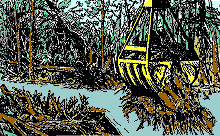
|
Activity: Understanding Land Use Practices
A Map Reading and GIS Exercise
Procedure:
- Duplicate and distribute copies of Worksheet 1 and the associated GIS map(s) in the Appendix. Transparencies of the worksheets and maps work well as teaching aids.
- Begin by reading items from the section entitled "Notice" to the students (Worksheet 1) and promoting discussion by exploring the possible relationships of map-related questions to the ideas listed under the section entitled "Consider", and by suggesting avenues available for further research ("Research"' section) .
- Encourage students to further explore topics related to maps and land use considerations by showing them examples of "starting points" which the educator has already located and/or obtained from the library. Outline possible directions to take when attempting literature searches in the library (e.g., periodicals, journals, books, non-print media, Internet resources).
The term "land use" refers to the many possible ways in which we manipulate our environment by using natural resources. For example, land use practices can be understood as the many ways in which we use land; agricultural areas, natural (undisturbed) areas, parks, urban areas, etc.
[Please refer to Appendix for GIS (geographic information system) maps]
GIS maps can be used to graphically illustrate a number of pertinent features about a given geographic area. These data are graphically over-laid upon an existing map and "locked-down" by geo-referencing the data to a specific latitude and longitude. Some examples of data geo-referenced to area maps are: Vegetation patterns (distribution and types), Land use patterns (agricultural vs. urban vs. wetlands, etc.), Temperature gradients, Soil characteristics, Various urban characteristics (e.g. streets, power grids, voting districts, economic distribution, etc.)
"Land use" also refers to the particular strategy an individual, or group of individuals applies to the utilization of natural resources. One might consider the land use practices of a nomadic people to be low-impact and self-sustaining, as is usually the case. On the other hand, a highly industrialized society often uses natural resources with an avariciousness sometimes bordering upon the absurd... as if natural resources will never be completely consumed, or that the problem can be dealt with by later generations.
Let's consider our own society, and even more specifically, our own region of the state. As one can see from the GIS maps, land use patterns in the Lake Pontchartrain Basin have changed dramatically from the 1950s to the 1990s.
? ? ? ? ? ? ? ? ? ? ? ? ? ? ? ? ? ? ? ? ? ? ? ?
Why do you suppose land use patterns have changed so much?
? ? ? ? ? ? ? ? ? ? ? ? ? ? ? ? ? ? ? ? ? ? ? ?
What are the most noticeable changes that have occurred during this time period?
? ? ? ? ? ? ? ? ? ? ? ? ? ? ? ? ? ? ? ? ? ? ? ?
How do you think the changes in the amount and kinds of land we now have affects pollution levels in the Lake Pontchartrain Basin and, as a direct result, our overall environmental quality?
? ? ? ? ? ? ? ? ? ? ? ? ? ? ? ? ? ? ? ? ? ? ? ?
Most libraries will contain excellent resources to use as a starting point for further exploration of this topic, both in traditional books and journals as well as Internet publications. Keywords for searching are: land use, conservation biology, resource management, GIS (geographic information systems), human population ecology, population explosion.
|




